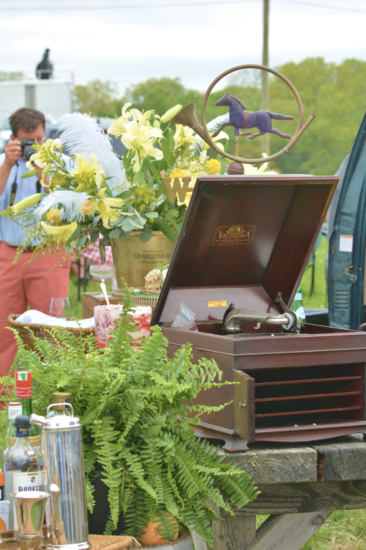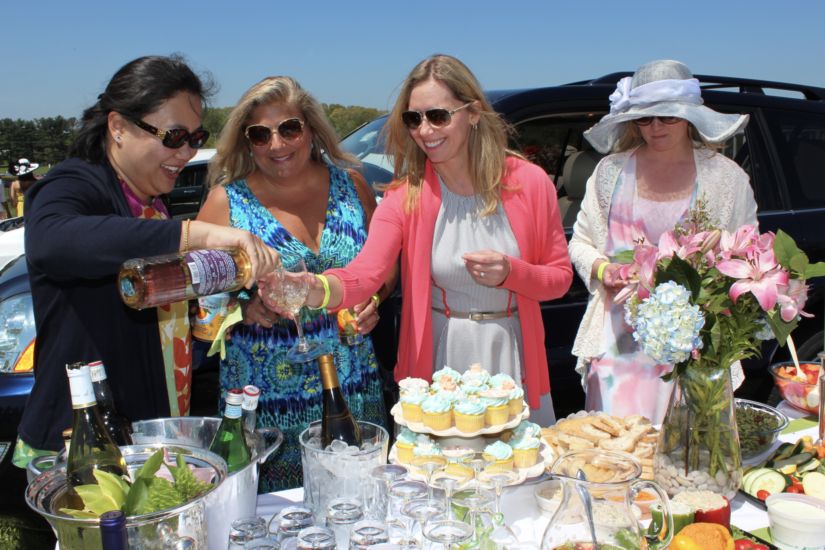Seven suggestions to help you cover the bases this spring and summer

When the pandemic threatened the hand sanitizer supply, Kathy Berg initially panicked. Husband Jim calmly told her to look in the “tailgate bag.” The Bergs are enthusiastic supporters of U.S. Naval Academy sports teams, and they tailgate so often they have staples ready to go. Long before COVID-19, she had learned that sanitizer and wipes are game-day essentials.
Berg is not the only one who is a seasoned tailgating pro. Recently, Susan Teiser, chef-owner of Montrachet Fine Foods in Centreville, prepared “tailgate” foods for socially distanced outings. The caterer is no stranger to the lavish spreads that characterize Winterthur’s Point-to-Point Steeplechase, which returns on May 30 after taking 2020 off. (The Willow Dale Steeplechase is May 8).
Tailgating diva Sandi Bihary-Waltz is a regular at Fireworks at Hagley celebrations. This year, the two-night event is scheduled for Aug. 13 and Aug. 20. Along with these annual celebrations, many outdoor concerts and performances allow picnics.
“Tailgating is fun, and we all need to have fun back in our lives,” says Jill Abbott, race director for Point-to-Point and an event planner at the museum. “I think the most important thing is planning. Tailgating does not have to be a lot of work if you plan and pace yourself as far as preparations — in other words, don’t wait until the last minute because it can make a long day longer.”
Now is the time to dust off your coolers and your tailgating approach. Here are some tips to help you get started.
1. Pick A Theme
A common thread connects all aspects of the event, from the attire to the décor to the food, Teiser says. Her favorites include music, such as favorite songs from the 1970s, French or Italian picnics and a season, such as spring and summer.
During her 23 years at Winterthur, Jill Abbott has seen it all, from the Radio City-style kick line to illustrate New York, New York to a tank that underscored a Patton theme. Spanish dancers once stomped around a tailgate saluting Madrid.
One year, for the “favorite song theme,” Abbott and friends chose “Hot, Hot, Hot.” All the food was spicy, except for the cucumber that they’d turned into shot glasses. Using washable paint, they covered a black Suburban with red chili peppers. She calls such efforts “extreme tailgating.”
These themes were once standard at Winterthur. Similarly, Fireworks at Hagley has a theme each year, and Bihary-Waltz matches her tailgate to it. “It can be an adventure,” she acknowledges. When there’s a patriotic theme, she breaks out the red, white and blue.
A theme requires décor. But even without one, flowers are a plus. Stargazer lilies are standard on Bihary-Waltz’s table. Use weighted vases so they won’t tip and flood your food, Abbott suggests.
Even if candles are not allowed, a candelabra adds drama at more formal outings. “The taller, the better,” Teiser says. Stagger the height of any item by bringing boxes that you can drape with fabric.

2. Make It Fun
A theme adds to the entertainment value. So do games. Cornhole —named for the bags that contain corn, not beans — doesn’t take up much space in the car and gives guests something to do between eating and the big event. Tuck a container of kids’ bubbles in your bag. “They make everyone laugh,” Teiser says.
Bihary-Waltz prefers to walk the grounds and “vote” for tailgates in categories such as “most sophisticated,” “cleverest” or “prettiest.”
3. Create A Menu
Since tailgating can start early, Karen Wright of Old New Castle begins with a brunch of bagels, lox and all the accouterments — including mimosas. No matter what she and husband Darren devise as a theme, they always have a Thanksgiving-like dish, even in May. Favorites include muffins made with turkey, stuffing and cranberry on mashed sweet potatoes.
Berg, who was once asked to roast a turkey for a Winterthur tailgate, prefers to keep it simple for her events. For football games, she’s ordered pizza and barbecue. Similarly, Abbott prefers room temperature foods that guests can eat with their hands. “You don’t need a lot of utensils,” she says. Plus, guests don’t need to juggle plates and glasses.
You don’t need to prepare all the food yourself. Montrachet has provided clients with fried chicken, mini croissant sandwiches, tea sandwiches, charcuterie and cheese boards, crab claws with cocktail sauce, brownies and blondies, and cookies.
Janssen’s Market in Greenville offers a create-your-own picnic basket. Choose the starters, sandwiches or entrees, sides and sweets from a list. Selections include barbecued ribs, baked or fried chicken, deviled eggs, wings, sesame noodles and lemon-blueberry cheesecake cups.
4. Take Cover
If allowed, canopies and open-sided tents let the party continue even in inclement weather, Teiser notes. Darren Wright made “food tents” to protect food from rain. “They look like the sneeze guards you’d see at a buffet,” his wife says.
The Wrights also bring tablecloths to both dress the popup tables and hide the supplies kept underneath them.
5. Carry With Ease
Bihary-Waltz can’t say enough about her wheeled cart. “It looks like an adult wagon and folds up to the size of a suitcase,” the Greenville resident explains. The Amazon purchase has proved valuable at Hagley, where guests must tote items from a parking area to the picnic area.
If you are hauling supplies from a considerable distance from the car, consider disposable food carriers that let you leave with less. “They’re creative and practical, Teiser says. She also recommends lightweight serving equipment. “The plastic designs today are amazing.”
Also, think clear, plastic glasses for beverages. “It’s not fun to drink wine out of a Solo cup,” notes Paula Janssen of Janssen’s Market, “and your stemware probably won’t make the trip home.”
Wright, however, brings glassware and fancy serving dishes to Point to Point. “It just needs to look pretty,” she maintains.
6. Stay Hot or Cold
Depending on the temperature, you’ll need ice. “Plan to bring one cooler just with ice — you will need it as the day goes along,” Janssen says. “Also, it’s great to separate your ice for drinks from the ice that is keeping things cold. Much cleaner. Food safety is hard in an outdoor setting and ice is your friend.” Tip: Put labels on each cooler.
For cold foods, Wright uses a standard cooler. Small hot or cold items, however, go in separate foldable Styrofoam carriers. For large events, the family has used insulated carriers that hold five food pans. Use one for hot and another for cold foods.
Bihary-Waltz uses a slow cooker for sausages and peppers in red sauce. Even unplugged, it will retain its heat for several hours. Berg has a device that plugs into the car’s 12-volt outlet to keep items warm. But if you don’t want to invest in a hot-food carrier, heat bricks in an oven, wrap them in foil and line a cooler’s bottom with them, Abbott says.
7. Pack A Tailgating Toolbox
Of course, you need more than food and a way to carry it. You will undoubtedly be glad you packed the following items:
• Foldable Table. Pack it first and load items on top, Abbott says.
• Tablecloths, linens or napkins.
• Paper towels, wet wipes and hand sanitizer — lots of it.
• Cutlery, serving spoons, tongs, glasses and plates.
• Serrated knife. Janssen wraps hers in napkins and plastic
to keep it safe. “You will need it. I promise.” Berg stocks up on
inexpensive paring knives from Pampered Chef.
• Ice buckets and separate cooler for ice.
• Portable grill or firepit if permitted and warranted, and the
supplies for them.
• A bottle opener-corkscrew. Abbot ties one to the cooler so it
won’t get misplaced.
• Camping chairs — bring extra in case your guests forget.
• Umbrellas, blankets, sunscreen and a change of clothing or
additional clothing and shoes. “At Point-to-Point, you never
know if it’s going to be 50 or 80 degrees,” Wright notes.
• Bungee cords.
• Saran wrap, foil, garbage bags and freezer bags for leftovers.
• Condiment caddies (or a cardboard six-pack holder).
• Painter’s or masking tape and a Sharpie.
• First-Aid kit.
• And, of course, duct tape.




